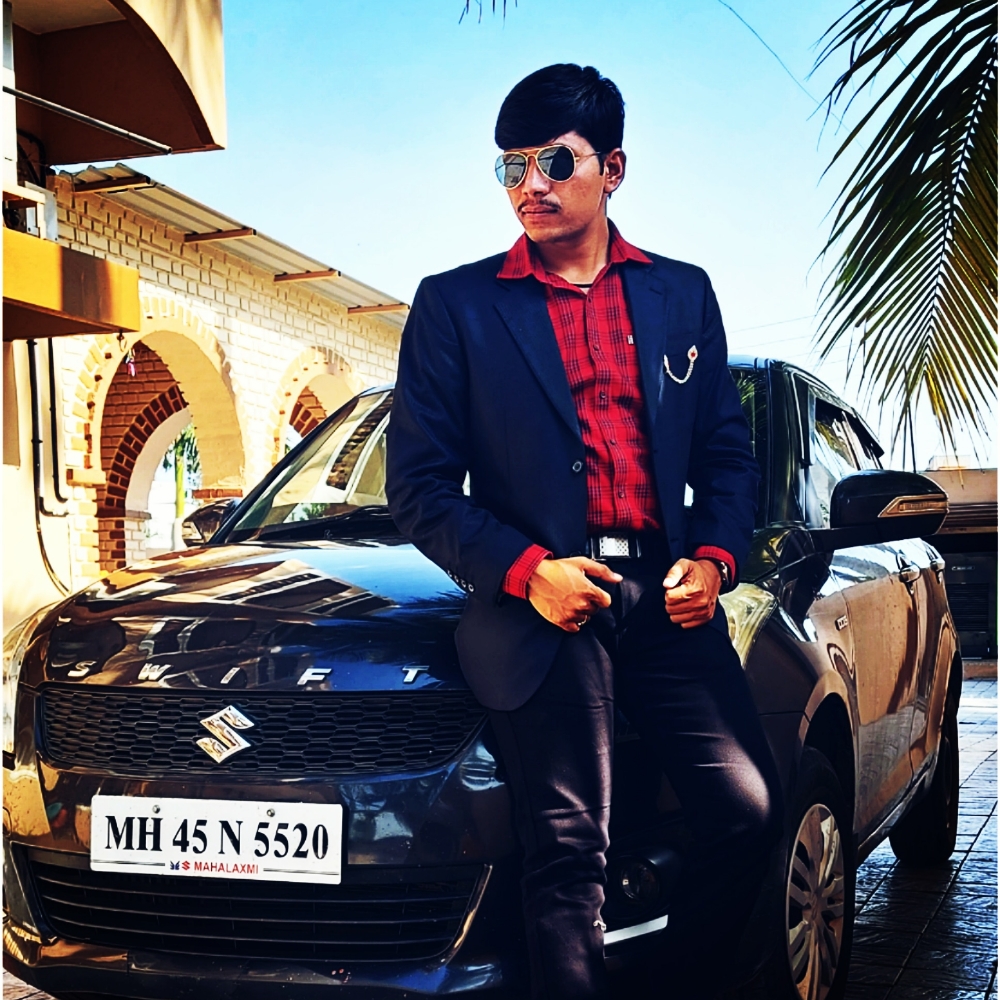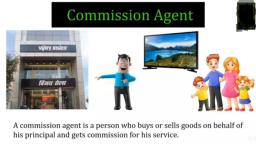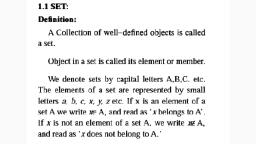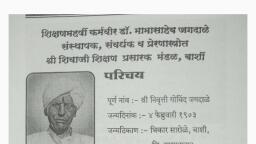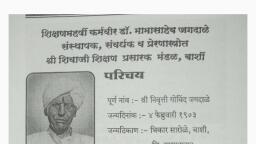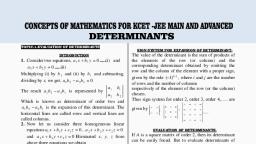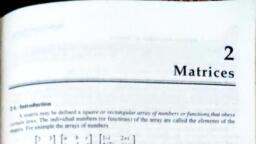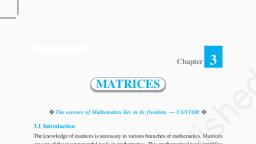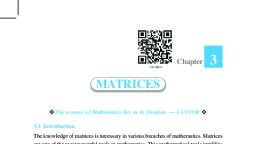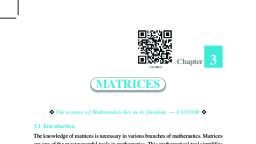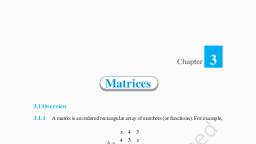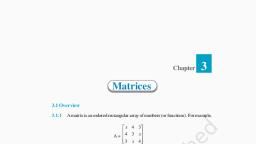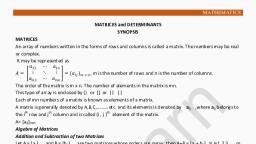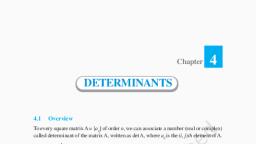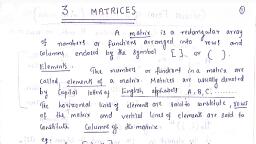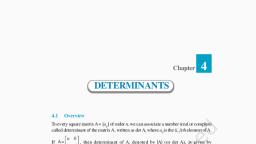Page 1 :
Matrices, Introduction
Page 2 :
Matrices - Introduction, Matrix algebra has at least two advantages:, •Reduces complicated systems of equations to simple, expressions, •Adaptable to systematic method of mathematical treatment, and well suited to computers, Definition:, , A matrix is a set or group of numbers arranged in a square or, rectangular array enclosed by two brackets, , 1, , − 1, , 4 2, − 3 0, , , , a b , c d , ,
Page 3 :
Matrices - Introduction, Properties:, •A specified number of rows and a specified number of, columns, •Two numbers (rows x columns) describe the dimensions, or size of the matrix., Examples:, 3x3 matrix, 2x4 matrix, 1x2 matrix, , 1 2 4 , 4 − 1 5 1 1, , , 3 3 3 0 0, , 3 − 3, , 3 2 , , 1, , − 1
Page 5 :
Matrices - Introduction, TYPES OF MATRICES, 1. Column matrix or vector:, The number of rows may be any integer but the number of, columns is always 1, , 1 , 4, , 2, , 1, − 3, , , a11 , a21 , , , am1
Page 6 :
Matrices - Introduction, TYPES OF MATRICES, 2. Row matrix or vector, Any number of columns but only one row, , 1, , 1 6, , a11, , a12, , 0, , 3 5 2, , a13 a1n
Page 7 :
Matrices - Introduction, TYPES OF MATRICES, 3. Rectangular matrix, , Contains more than one element and number of rows is not, equal to the number of columns, , 1 1 , 3 7 , , , 7 − 7 , , , 7 6 , , 1 1 1 0 0 , 2 0 3 3 0, , , , mn
Page 8 :
Matrices - Introduction, TYPES OF MATRICES, 4. Square matrix, The number of rows is equal to the number of columns, , (a square matrix A has an order of m), mxm, , 1 1, 3 0, , , , 1 1 1, 9 9 0, , , 6 6 1, , The principal or main diagonal of a square matrix is composed of all, elements aij for which i=j
Page 9 :
Matrices - Introduction, TYPES OF MATRICES, 5. Diagonal matrix, A square matrix where all the elements are zero except those on, the main diagonal, , 1 0 0, 0 2 0 , , , 0 0 1, i.e. aij =0 for all i = j, , aij = 0 for some or all i = j, , 3, 0, , 0, , 0, , 0, 3, 0, 0, , 0, 0, 5, 0, , 0, 0, 0, , 9
Page 10 :
Matrices - Introduction, TYPES OF MATRICES, 6. Unit or Identity matrix - I, , A diagonal matrix with ones on the main diagonal, , 1, 0, , 0, , 0, , 0, 1, 0, 0, , 0, 0, 1, 0, , 0, 0, 0, , 1, , i.e. aij =0 for all i = j, , aij = 1 for some or all i = j, , 1 0, 0 1 , , , , aij, 0, , , 0, aij
Page 11 :
Matrices - Introduction, TYPES OF MATRICES, 7. Null (zero) matrix - 0, All elements in the matrix are zero, , 0 , 0 , , 0, , aij = 0, , 0 0 0 , 0 0 0 , , , 0 0 0, For all i,j
Page 12 :
Matrices - Introduction, TYPES OF MATRICES, 8. Triangular matrix, , A square matrix whose elements above or below the main, diagonal are all zero, , 1 0 0 , 2 1 0, , , 5 2 3, , 1 0 0 , 2 1 0, , , 5 2 3, , 1 8 9, 0 1 6 , , , 0 0 3
Page 13 :
Matrices - Introduction, TYPES OF MATRICES, 8a. Upper triangular matrix, A square matrix whose elements below the main, diagonal are all zero, , aij, , 0, 0, , , aij, aij, 0, , aij , , aij , aij , , i.e. aij = 0 for all i > j, , 1 8 7 , 0 1 8 , , , 0 0 3, , 1, 0, , 0, , 0, , 7, 1, 0, 0, , 4, 7, 7, 0, , 4, 4, 8, , 3
Page 14 :
Matrices - Introduction, TYPES OF MATRICES, 8b. Lower triangular matrix, A square matrix whose elements above the main diagonal are all, zero, , aij, , aij, aij, , , 0, aij, aij, , 0, , 0, aij , , i.e. aij = 0 for all i < j, , 1 0 0 , 2 1 0, , , 5 2 3
Page 15 :
Matrices – Introduction, TYPES OF MATRICES, 9. Scalar matrix, , A diagonal matrix whose main diagonal elements are, equal to the same scalar, A scalar is defined as a single number or constant, , aij, , 0, 0, , , 0, aij, 0, , 0, , 0, aij , , i.e. aij = 0 for all i = j, aij = a for all i = j, , 1 0 0, 0 1 0 , , , 0 0 1, , 6, 0, , 0, , 0, , 0, 6, 0, 0, , 0, 0, 6, 0, , 0, 0, 0, , 6
Page 16 :
Matrices, Matrix Operations
Page 17 :
Matrices - Operations, EQUALITY OF MATRICES, Two matrices are said to be equal only when all, corresponding elements are equal, Therefore their size or dimensions are equal as well, , A=, , 1 0 0 , 2 1 0, , , 5 2 3, , B=, , 1 0 0 , 2 1 0, , , 5 2 3, , A=B
Page 19 :
Matrices - Operations, ADDITION AND SUBTRACTION OF MATRICES, , The sum or difference of two matrices, A and B of the same, size yields a matrix C of the same size, , cij = aij + bij, Matrices of different sizes cannot be added or subtracted
Page 20 :
Matrices - Operations, Commutative Law:, A+B=B+A, Associative Law:, A + (B + C) = (A + B) + C = A + B + C, , 5 6 8, 8 5, 7 3 − 1 1, 2 − 5 6 + − 4 − 2 3 = − 2 − 7 9 , , , , , A, 2x3, , B, 2x3, , C, 2x3
Page 21 :
Matrices - Operations, A+0=0+A=A, A + (-A) = 0 (where –A is the matrix composed of –aij as elements), , 6 4 2 1 2 0 5 2 2 , 3 2 7 − 1 0 8 = 2 2 − 1, , , ,
Page 22 :
Matrices - Operations, SCALAR MULTIPLICATION OF MATRICES, Matrices can be multiplied by a scalar (constant or single, element), Let k be a scalar quantity; then, kA = Ak, Ex. If k=4 and, , 3 − 1, 2 1 , , A=, 2 − 3, , , 4 1
Page 23 :
Matrices - Operations, 3 − 1 3 − 1, 12 − 4 , 2 1 2 1 , 8 4 , =, 4 = , , 4 , 2 − 3 2 − 3, 8 − 12, , , , , , 4, 1, 4, 1, 16, 4, , , , , , Properties:, • k (A + B) = kA + kB, • (k + g)A = kA + gA, • k(AB) = (kA)B = A(k)B, • k(gA) = (kg)A
Page 24 :
Matrices - Operations, MULTIPLICATION OF MATRICES, The product of two matrices is another matrix, Two matrices A and B must be conformable for multiplication to, be possible, i.e. the number of columns of A must equal the number of rows, of B, , Example., A, , (1x3), , x, , B =, , (3x1), , C, , (1x1)
Page 27 :
Matrices - Operations, 4 8 , 1 2 3 , (1 4) + (2 6) + (3 5) (1 8) + (2 2) + (3 3) , , 4 2 7 6 2 = (4 4) + (2 6) + (7 5) (4 8) + (2 2) + (7 3), , 5 3 , , , , , 31 21, =, , 63, 57, , , Remember also:, IA = A, , 1 0 31 21, 0 1 63 57 , , , , , 31 21, =, , 63, 57, ,
Page 28 :
Matrices - Operations, Assuming that matrices A, B and C are conformable for, the operations indicated, the following are true:, 1. AI = IA = A, , 2. A(BC) = (AB)C = ABC - (associative law), 3. A(B+C) = AB + AC - (first distributive law), 4. (A+B)C = AC + BC - (second distributive law), , Caution!, 1. AB not generally equal to BA, BA may not be conformable, 2. If AB = 0, neither A nor B necessarily = 0, 3. If AB = AC, B not necessarily = C
Page 29 :
Matrices - Operations, AB not generally equal to BA, BA may not be conformable, , 1 2, T =, , 5, 0, , , 3 4, S=, , 0, 2, , , 1 2 3, TS = , 0, 5, 0, , , 3 4 1, ST = , 5, 0, 2, , , , 4 3 8 , =, , 2 15 20, 2 23 6, =, , 0 10 0
Page 30 :
Matrices - Operations, If AB = 0, neither A nor B necessarily = 0, , 3 0 0 , 1 1 2, 0 0 − 2 − 3 = 0 0, , , ,
Page 31 :
Matrices - Operations, TRANSPOSE OF A MATRIX, If :, , 2 4 7 , A= 2 A = , , 5, 3, 1, 2x3, , , 3, , Then transpose of A, denoted AT is:, , A =2 A, T, , 3T, , 2 5, = 4 3, 7 1, , aij = a, , T, ji, , For all i and j
Page 32 :
Matrices - Operations, To transpose:, , Interchange rows and columns, The dimensions of AT are the reverse of the dimensions of A, , 2 4 7 , A= 2 A = , , 5, 3, 1, , , 3, , T2, , A =3 A, T, , 2 5, , , = 4 3, 7 1, , 2x3, , 3x2
Page 33 :
Matrices - Operations, Properties of transposed matrices:, 1. (A+B)T = AT + BT, , 2. (AB)T = BT AT, 3. (kA)T = kAT, 4. (AT)T = A
Page 34 :
Matrices - Operations, 1. (A+B)T = AT + BT, 5 6 8, 8 5, 7 3 − 1 1, 2 − 5 6 + − 4 − 2 3 = − 2 − 7 9 , , , , , , 2 1 − 4 8 − 2, 7, 3 − 5 + 5 − 2 = 8 − 7 , , , , , − 1 6 6 3 5 9 , , 8 − 2, 8 − 7 , , , 5 9
Page 35 :
Matrices - Operations, (AB)T = BT AT, , 1 , 1 1 0 2, 0 2 3 1 = 8 2 8, , 2 , , 1 0, 1 1 21 2 = 2 8, 0 3
Page 36 :
Matrices - Operations, SYMMETRIC MATRICES, A Square matrix is symmetric if it is equal to its, transpose:, A = AT, , a, A=, b, a, T, A =, b, , b, d , b, d
Page 37 :
Matrices - Operations, When the original matrix is square, transposition does not, affect the elements of the main diagonal, , a b , A=, , c, d, , , a c , T, A =, , b, d, , , The identity matrix, I, a diagonal matrix D, and a scalar matrix, K,, are equal to their transpose since the diagonal is unaffected.
Page 38 :
Matrices - Operations, INVERSE OF A MATRIX, Consider a scalar k. The inverse is the reciprocal or division of 1, by the scalar., Example:, , k=7, , the inverse of k or k-1 = 1/k = 1/7, , Division of matrices is not defined since there may be AB = AC, while B = C, Instead matrix inversion is used., The inverse of a square matrix, A, if it exists, is the unique matrix, A-1 where:, AA-1 = A-1 A = I
Page 39 :
Matrices - Operations, Example:, , 3, A= 2 A = , 2, 1, −1, A =, − 2, 2, , Because:, , 1, 1, − 1, 3 , , 1 − 1 3 1 1, − 2 3 2 1 = 0, , , , 3 1 1 − 1 1, 2 1 − 2 3 = 0, , , , , 0, 1, 0, 1
Page 40 :
Matrices - Operations, Properties of the inverse:, , ( AB) −1 = B −1 A−1, ( A−1 ) −1 = A, ( AT ) −1 = ( A−1 )T, 1 −1, −1, (kA) = A, k, A square matrix that has an inverse is called a nonsingular matrix, A matrix that does not have an inverse is called a singular matrix, Square matrices have inverses except when the determinant is zero, When the determinant of a matrix is zero the matrix is singular
Page 41 :
Matrices - Operations, DETERMINANT OF A MATRIX, To compute the inverse of a matrix, the determinant is required, Each square matrix A has a unit scalar value called the, determinant of A, denoted by det A or |A|, , If, , then, , 1 2, A=, , 6, 5, , , 1 2, A=, 6 5
Page 42 :
Matrices - Operations, If A = [A] is a single element (1x1), then the determinant is, defined as the value of the element, Then |A| =det A = a11, If A is (n x n), its determinant may be defined in terms of order, (n-1) or less.
Page 43 :
Matrices - Operations, MINORS, If A is an n x n matrix and one row and one column are deleted,, the resulting matrix is an (n-1) x (n-1) submatrix of A., , The determinant of such a submatrix is called a minor of A and, is designated by mij , where i and j correspond to the deleted, row and column, respectively., mij is the minor of the element aij in A.
Page 47 :
Matrices - Operations, DETERMINANTS CONTINUED, The determinant of an n x n matrix A can now be defined as, , A = det A = a11c11 + a12 c12 + + a1n c1n, The determinant of A is therefore the sum of the products of the, elements of the first row of A and their corresponding cofactors., (It is possible to define |A| in terms of any other row or column, but for simplicity, the first row only is used)
Page 49 :
Matrices - Operations, Example 1:, , 3 1 , A=, , 1, 2, , , , A = (3)(2) − (1)(1) = 5
Page 53 :
Matrices - Operations, ADJOINT MATRICES, , A cofactor matrix C of a matrix A is the square matrix of the same, order as A in which each element aij is replaced by its cofactor cij ., Example:, If, , 1 2, A=, , −, 3, 4, , , , The cofactor C of A is, , 4 3, C=, , −, 2, 1, ,
Page 54 :
Matrices - Operations, The adjoint matrix of A, denoted by adj A, is the transpose of its, cofactor matrix, , adjA = C T, , It can be shown that:, A(adj A) = (adjA) A = |A| I, Example:, , 1 2, A=, , −, 3, 4, , , A = (1)(4) − (2)(−3) = 10, 4 − 2, adjA = C = , , 3, 1, , , T
Page 55 :
Matrices - Operations, 1 2 4 − 2 10 0 , A(adjA) = , =, = 10 I, , , , , − 3 4 3 1 0 10, , 4 − 2 1 2 10 0 , (adjA) A = , =, = 10 I, , , , , 3 1 − 3 4 0 10
Page 56 :
Matrices - Operations, USING THE ADJOINT MATRIX IN MATRIX INVERSION, Since, AA-1 = A-1 A = I, and, , A(adj A) = (adjA) A = |A| I, , then, , adjA, A =, A, −1
Page 57 :
Matrices - Operations, Example, , A=, , 1 2, − 3 4, , , , 1 4 − 2 0.4 − 0.2, A = , =, , 10 3 1 0.3 0.1 , −1, , To check, , AA-1 = A-1 A = I, , 1 2 0.4 − 0.2 1, AA = , =, , , , − 3 4 0.3 0.1 0, 0.4 − 0.2 1 2 1, −1, A A=, =, , , , 0.3 0.1 − 3 4 0, −1, , 0, =I, , 1, 0, =I, , 1
Page 58 :
Matrices - Operations, Example 2, , 3 − 1 1 , A = 2 1 0 , 1 2 − 1, , The determinant of A is, |A| = (3)(-1-0)-(-1)(-2-0)+(1)(4-1) = -2, The elements of the cofactor matrix are, , c11 = +(−1),, , c12 = −(−2),, , c13 = +(3),, , c21 = −(−1),, , c22 = +(−4),, , c23 = −(7),, , c31 = +(−1),, , c32 = −(−2),, , c33 = +(5),
Page 59 :
Matrices - Operations, The cofactor matrix is therefore, 3, − 1 2, C = 1 − 4 − 7 , − 1 2, 5 , , so, , and, , − 1 1 − 1, adjA = C T = 2 − 4 2 , 3 − 7 5 , , − 1 1 − 1 0.5 − 0.5 0.5 , adjA 1 , = − 1.0 2.0 − 1.0 , A−1 =, =, 2, −, 4, 2, , , A, −2 , 3 − 7 5 − 1.5 3.5 − 2.5
Page 60 :
Matrices - Operations, The result can be checked using, AA-1 = A-1 A = I, The determinant of a matrix must not be zero for the inverse to, exist as there will not be a solution, Nonsingular matrices have non-zero determinants, , Singular matrices have zero determinants
Page 61 :
Matrix Inversion, Simple 2 x 2 case
Page 62 :
Simple 2 x 2 case, Let, , a b , A=, , c, d, , , , and, , w x, A =, , y, z, , , , Since it is known that, A A-1 = I, then, , a b w x 1 0, c d y z = 0 1 , , , , , , −1
Page 63 :
Simple 2 x 2 case, Multiplying gives, , aw + by = 1, ax + bz = 0, cw + dy = 0, cx + dz = 1, It can simply be shown that, , A = ad − bc
Page 64 :
Simple 2 x 2 case, thus, , 1 − aw, y=, b, − cw, y=, d, 1 − aw − cw, =, b, d, d, d, w=, =, da − bc A
Page 65 :
Simple 2 x 2 case, − ax, b, 1 − cx, z=, d, − ax 1 − cx, =, b, d, b, b, x=, =−, − da + bc, A, z=
Page 66 :
Simple 2 x 2 case, 1 − by, w=, a, − dy, w=, c, 1 − by − dy, =, a, c, c, c, y=, =−, − ad + cb, A
Page 67 :
Simple 2 x 2 case, − bz, x=, a, 1 − dz, x=, c, − bz 1 − dz, =, a, c, a, a, z=, =, ad − bc A
Page 68 :
Simple 2 x 2 case, So that for a 2 x 2 matrix the inverse can be constructed, in a simple fashion as, , w x, A =, =, , y z, −1, , d, A, , − c, A, , , b, A 1 d − b, = , a A − c a , A , , •Exchange elements of main diagonal, •Change sign in elements off main diagonal, •Divide resulting matrix by the determinant
Page 69 :
Simple 2 x 2 case, Example, , 2 3, A=, , 4, 1, , , 1 1 − 3 − 0.1 0.3 , −1, A =− , =, , 10 − 4 2 0.4 − 0.2, Check inverse, A-1 A=I, , 1 1 − 3 2 3 1 0, − , =, =I, , , , , 10 − 4 2 4 1 0 1
Page 70 :
Matrices and Linear Equations, Linear Equations
Page 73 :
Linear Equations, If the determinant is nonzero, the equation can be solved to produce, n numerical values for x that satisfy all the simultaneous equations, To solve, premultiply both sides of the equation by A-1 which exists, because |A| = 0, A-1 AX = A-1 B, , Now since, A-1 A = I, We get, , X = A-1 B, , So if the inverse of the coefficient matrix is found, the unknowns,, X would be determined
Page 75 :
Linear Equations, When A-1 is computed the equation becomes, , 0.5 − 0.5 0.5 2 2 , X = A−1 B = − 1.0 2.0 − 1.0 1 = − 3, − 1.5 3.5 − 2.5 3 7 , Therefore, , x1 = 2,, x2 = −3,, x3 = −7
